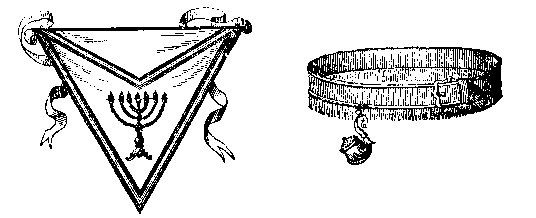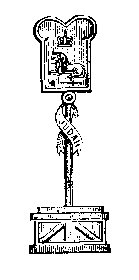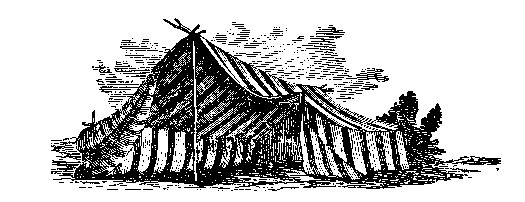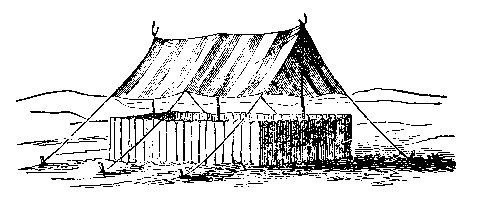The Web of Hiram |
Degrees of the Ancient and Accepted Scottish Rite14. Grand Elect, Perfect and Sublime Master Mason 15. Knight of the East or Sword 17. Knights of the East and West 18. Knight of the Rose-Croix de Heredom 20. Grand Master of all Symbolic Lodges 21. Noachite or Prussian Knight 25. Knight of the Brazen Serpent 29. Knight of St Andrew, or Patriarch of the Crusades |
CHIEF OF THE TABERNACLEThe Twenty-Third Grade of the Ancient and Accepted Scottish Rite and the Fifth Degree of the Historical and Philosophical Series
ARGUMENTThis degree is intimately connected with, and is preliminary to, that which immediately follows, called Prince of the Tabernacle. The form of the Tabernacle is distinctly defined, and the old sacerdotal ceremonies of the ancient temples described and portrayed, with useful explanation and instruction. Unholy sacrilege and presumptuous interference with sacred ceremonies are forbidden and punished; and only those with hearts divested of all impurity, are commended in the performance of holy rites. THE LODGE-ITS DECORATIONS, ETCLodges in this degree are styled Courts. The hangings are white, supported by red and black columns, by twos, placed at intervals, according to the taste of the architect. The Court represents an encampment of the Twelve Tribes, in the desert, near Sinai. The standards of the tribes, made after the following model,
are planted around the Court near the walls, in the following order: In the East, that of Judah: the colour of the standard being crimson, in stripes or waves; and the device a Lion, couchant, between a crown and sceptre. Next to Judah, on the side toward the North, that of Issachar: colour of the standard, greenish yellow; device, an Ass, couchant, between two burdens or packs. Next to Judah, on the side toward the South, that of Zebulon: colour, light green, and device a Ship. Next toward the South, that of Simeon: colour yellow; device, a naked Sword. In the South, that of Reuben: colour a brilliant crimson; device, a Man. Next to Reuben, on the side toward the West, that of Gad: colour, bluish green; device, a field covered with Stars. Next toward the West, that of Manasseh: colour variegated. like agate; device, a Vine running over a wall. In the West, that of Ephraim: colour variegated, like opal; device, a Bull. Next toward the North, that of Benjamin: colour, violet; device, a Wolf Next toward the North, that of Asher: colour, blue; device, a Tree in full leaf. In the North, that of Dan: colour, that of the gold-stone; device, an Eagle, holding a serpent in his beak. Next to Dan, toward the East, that of Naphtali: colour, bluish green; device, a female Deer running at speed. In the centre of the Lodge is a representation, reduced in size, of the Tabernacle of Moses, described in Exodus, Chapters xxvL and xxxvi., as nearly accurate as circumstances and the means of the Court will allow. First comes the Court of the Tabernacle, which was a rectangular enclosure, 150 feet long from East to West, (if the cubit be taken to have been 18 inches), and 75 feet wide, from North to South. It was formed (except the gate or entrance) by curtains of white linen, 7.5 feet high, supported by pillars of acacia-wood, set in brass sockets, and with hooks and fillets of silver. There were of these pillars, 20 on the North side, 20 in the South, and 10 in the West. On the East, the white curtains on each side of the entrance measured 22.5 feet, and were supported by three pillars on each side. The gate itself was 30 feet wide, formed by curtains of tapestry, of blue, scarlet, purple, and white linen thread, wrought with admirable skill in needlework. Within the Court, the Tabernacle Mishkan was set. It was a double tent, the foregoing word particularly applying to the inner curtains, and Ahel, to the outer curtains of goat's hair. The Tabernacle is also termed Mikdash, or Sanctuary. It was constructed of curtains, woven of fine thread, of white linen, blue, purple, and scarlet, embroidered with cherubin. The length of each curtain was twenty-three cubits or forty-two feet, and each was six feet in width. They were ten in number; and five of them were coupled or sewed together in one piece, and five in another; and these two were so arranged that they could be fastened together along their edges, by fifty loops on one edge of each, and fifty hooks of gold; so that "it should become one Tabernacle."
Over this Tabernacle was a Tent [Ahel] or cover, of cloth of goats' hair, composed of eleven curtains, each thirty cubits or forty~five feet long, and six feet wide. Of these, five were coupled together in one piece, and six in another; and the two pieces were so arranged, with fifty loops on one edge of each, and fifty hooks of brass, that they could be fastened together, " that it might be one." In the East, and especially in Arabia, customs and fashions have not changed; and the shape of the tent is now what it was in the days of Moses. The shape of the tent is of an oblong, eight or ten feet high in the middle. It can vary in size, and have accordingly a greater or less number of poles to support it-from three to nine. And it is usual for one large tent to be divided into two or more apartments by curtains, for the different portions of the family. The tents of the Bedouins are not conical, as they are often represented in pictures, but have a roof edged with drop-curtains, or such curtains as might be made from the dark tanned skins of-goats, hung around the eaves. Below is a drawing of a Bedouin tent.
Thus the Tabernacle in the Court-room should represent a tent, oblong in shape, stretched upon a frame of poles and forks, one pole in the middle serving as a ridge-pole. Over this, hanging to the floor, on the North and South sides, and the rear or West, and stretching on top, on each side, to and over the ridge pole, should be two curtains, joining together by hooks and loops in the middle of the rear, of white, blue, scarlet, and purple linen or cotton thread woven together, and embroidered with cherubim, or animals with the bodies of lions, the feet of oxen, the faces of men, and the wings of eagles. Over this should be similar curtains of gray woollen stuff; and on top, as a covering red morocco, and over that, tanned leather. The hanging curtain at the mouth of the tent, and the veil dividing the Tabernacle into two parts, should be as above described; as also should the enclosure of the Court, if not the fence. The furniture of the Court is as follows: In front of, and perhaps ten feet from the entrance of the Tabernacle, is the altar of sacrifice, made of white wood, hollow, and plated on top with brass. It is to be four and a half feet high, and seven and a half feet square, with projections in the shape of tongues of flame (called horns in the Bible) at each corner, standing up-right. It is made to be carried by staves of light wood, banded with brass, passing through rings in two of the sides. Between this altar and the Tabernacle is a laver or large basin of bronze, with a foot to it, filled with water. In the front part of the tent, in front of the veil, on the North side, is the Table of the Presence or Shew-bread. It is made of white wood, and is three and a half feet long, one and a half feet broad, and two and one-fourth feet high, the top covered with plates of brass, gilded, and with a gilded rim or border round its edge on the top. Below the top is a strip of wood four inches wide, with a similar rim or border round its lower edge. A little lower down, at equal distances from the top, is a ring, gold-plated, on each leg, through which gilded staves pass to carry it. On this table are twelve small loaves of wheat bread, in two piles of six each, sprinkled with frankincense and salt; and a large bowl of pure wine. On the south side of the tent, opposite the table, is the candelabrum, gilded, representing pure gold. It consists of an ornamented base, of a shaft rising out of it, and six arms, coming out by threes from two opposite sides of the shaft, each two arms equidistant from the central shaft, forming a semicircle, and all being in one line and of equal height or level on top. On the summit of the central shaft, and on those of the six arms, are lamps, not candles, all in globular shades, but the central one being much the largest. These lamps are to be fed with pure olive-oil. Before the middle of the veil, and in the outer part of the tent, is the altar of incense, eighteen inches square and three feet high, with flames or horns of brass at each corner, the top covered with a plate of yellow metal, imitating gold, with a rim of the same round it, and two gold rings on each of two opposite sides, below the rim, for gilded staves or rods to pass through, by which to carry it. In the centre of the inner portion of the tent (the Kadosh Kadoshim, or Holy of Holies,) stands the Ark of the Covenant, of wood, three and three-fourth feet long, two and one-fourth feet broad, and two and one-fourth feet high, with short feet at each corner. It is plated within and without with brass, so as to appear like pure gold, and has round, its upper edge a rim or cornice, gilded to represent gold. On the two longer sides, at the corners, are four brass rings, to receive the staves of wood, gilded, by which it is carried. On the Ark is a lid, called the Expiatory (or Mercy-Seat), as long and wide as the Ark, and representing solid gold. At each end is, also, as of solid gold, a cherub, or winged figure of a female, each with two wings long enough to meet half-way between them, higher than their heads. Their heads should be bent down as though looking upon the Expiatory. On the altar of incense are the roll of the Book of the Law and a poniard; and on the Book of the Law, the Square and Compasses. The presiding officer sits in the East, represents Aaron, and is styled "Most Excellent High Priest." The Wardens sit in the West, and represent his two sons, Eleazar and Ithamar, 'and are styled "Excellent Priests." The Orator, Secretary, and Treasurer sit in the East of the Tabernacle, the Master of Ceremonies in the West of it, the Captain of Guards on the South of it, and the Sentinel on the North. The other officers and members sit on the North, South, and West of it. All except the first three officers are styled "Worthy Levites." The presiding officer wears a robe or gown, of pure white linen, reaching to the feet, fitting close to the body, with loose sleeves coming as low as the elbows - covering the shoulders, and closed round the neck. This is girded to the body, just under the breast, by a girdle four fingers broad, wound round and round the body from the breasts to the navel, and the ends hanging down to the ankles. The robe is embroidered with needlework, in different colors; and the girdle is of loosely woven white cotton, embroidered with flowers of blue, scarlet, and purple. Over the robe or gown is the " robe of the Ephod," an Egyptian tunic of blue stuff, woven in one piece, with an aperture for the neck in the middle of it, and apertures for the arms; without sleeves, large and loose, and reaching to the knees. Round the hem, at the bottom, is a fringe of blue, scarlet, and purple tassels, in the form of pomegranates, with a small gilded bell between each two; this is also tied round with a girdle, white, embroidered with blue, scarlet, and purple, and gold interwoven. He wears also the Ephod, a short cloak with the sleeves, of gold, blue, purple, scarlet, and fine linen thread, embroidered richly, and covering the shoulders, by shoulder pieces that unite the back and front parts, which are separate. On each shoulder of it is an agate, set in gold, and each having upon it six names of the tribes, according to precedence of birth. This Ephod has strings, that go out from each side, and tie to the body. He also wears the breastplate or gorget, ten inches square, of the same sort of cloth as the Ephod, doubled so as to form a kind of pouch, to hold the Aurim and Themim. On its outside are twelve precious stones, in four rows, as they are named in Exodus xviii. 17-20; on each side of which is engraved the name of one of the tribes. This is fastened to the front of the Ephod by means of dark blue ribbons, tied in four rings of gold at the corners of the breastplate, and four that meet them on the ephod itself . The rings at the upper corners are on the inside of the breastplate, but those below are outside. There are also two other rings of gold, larger, at the upper corners, on the outside, from which cords of twisted gold-thread reach and fasten to the agates on the shoulders. And it is further fastened by a sash or girdle, of the same stuff as itself, to which the lower side is attached, and which is tied in front of the body, and hangs down to the lower edge of the Ephod. The Urim or Aurim, and Thummim or Themim, carried in the pouch or breastplate, are small images of sapphire (or blue stone), of Re and Thmei, Light and Truth, in a sitting posture, each holding the tau cross. The bonnet is a turban of fine white linen, circular, covering half the head, something like a crown, of thick linen swathes doubled round many times, and sewed together, surrounded by a linen cover, to hide the seams of the swathes. The mitre of the High-Priest is this turban, with another above it, of swathes of blue, embroidered, so that the whole is conical in shape. In front of the turban, on the forehead, is a plate of gold, extending from one ear to the other, fastened by strings tied behind, and also by a blue ribbon attached to the mitre; on which is engraved the inscription: "HOLY TO THE LORD" The two Wardens wear the same dress in all respects, except the breastplate, and the mitre, instead of which they wear the bonnet or turban of white linen. The High-Priest and Wardens wear no apron. The other officers and members wear a white apron, lined with scarlet, and bordered with red, blue, and purple ribbons. In the middle is painted or embroidered the g olden candelabrum with seven lights. They also wear a red leather belt, fringed along the lower edge with gold, and edged with gold; from which hangs a small silver censer, or ornamented cup, with a long handle, the end whereof, on which the cup sits, in shaped like an open hand. This is also the form of the jewel of the degree. For receptions there is also a dark apartment, with an altar in the centre, on which are placed a feeble light and three skulls. In front of the altar is a skeleton. Battery - ** - ** - ** - * RECEPTION1. Thus shalt thou say to the house of Jacob, and tell the children of Israel: Ye have seen what I did unto the Mitzrayim, and how I bare you on the wings of eagles, and brought you unto myself. 2. Now, therefore, if you will obey my voice indeed, and keep my covenant, then ye shall be a peculiar treasure unto me, above all people; for all the earth is mine. 3. And ye shall be unto me a kingdom of priests, and a holy nation. These are the words which thou shalt speak unto the children of Israel. INVOCATIONH.: P.: O mighty and inscrutable Being, for whose very self there is no name whatever, and even the ineffable word expresses a limitation of thy infinite essence! Of whom all the deities of all the nations are but personifications of single attributes: we bow down unto thee as the simple absolute existence, that with a thought didst from thyself utter all the worlds! Eternal Father, of whose thought the universe is but a model Unchangeable! Coeval with time, and coextensive with Space! Whose laws of harmony, that thy will is, rule all the movements of the suns and worlds! Thou art the all: in Thee all things exist. O guide and guard us, and lead us safely toward thee, that we faint not by the wayside, nor wander into the darkness like lost children. Amen. All. So mote it be! LECTUREH.: P.: I accept and receive you, my brother, as a Levite and Chief of the Tabernacle, and consecrate and devote you henceforth to the service of the children of light; and I now invest you with the belt, jewel, and apron of this degree. The jewel, or censor is of silver, is ever to remind you to offer up unceasingly to God the incense of good deeds and charitable actions, dictated by a pure and upright heart. Josephus tells that the mixture of materials, in the curtains of the Tabernacle, and the clothing of the priests, was not without design. "It served," he says, "as a symbol of the universe. For the scarlet seemed emblematical of fire; the fine linen, of the earth; the blue, of the air; and the purple, of the sea; two of them being thus compared for their colour: the fine linen and the purple on account of their origin, as the earth produces the one, and the sea the other." To us, in this degree, the white of the apron, its principal and chief colour, is symbolical of the infinite beneficence of God; the blue, of His profound and perfect wisdom; the crimson, of His glory; and the purple, of His power. The candelabrum with seven branches, upon the apron, wrought in gold, represents to us, as it represented to our ancient Hebrew brethren, what were known in the earlier ages as the seven planets, or principal heavenly bodies: the Sun in the middle, with Mars, Jupiter, and Saturn on one side, and Venus, Mercury, and the Moon on the other. It also represents the seven archangels whom the Hebrews assigned to the government of those planets; Zerakhi-el, the Dawn, or Rising of God, to the Sun; Auri-el, the Light of God, to Mars; Gabari-el, the Strength of God, to Jupiter: Mayak-el, the Semblance of God, to Saturn; Khamali-el, the Mercy of God, to Venus; Raph-el, the Healing of God, to Mercury; and Tsaph-el , the Messenger of God, to the Moon: of whom Mayak-el, or Michael, was represented with the head of a lion; Auri-el, or Uriel, with that of an ox; Raph-el, or Raphael, with a human head and the body of a serpent; and Gabari-el, or Gabriel with that of an eagle; and all of the seven being attributes and manifestations of El, the great Semitic Nature-God of the ancient Patriarchs; as to whom, and these planets, and angels, and their connection with Masonry you will be more fully instructed as you advance The number 7 is the sacred number in all theogies and in all symbolisms. It is the spirit, assisted by all the elementary powers; the soul, served by nature ; the Holy Empire (Sanctum Regnum), spoken of in the clavicules of Solomon. It reappears everywhere in the Hebrew writings and in the Apocalypse; and here, particularly, in the seven lamps of the candelabrum. Under the symbols of the seven planets which it represents, the ancients figured the seven virtues so peculiarly Masonic: Faith, that aspiration toward the infinite, was represented by the Sun; Hope by the Moon; Charity, by Venus; Force (or Fortitude), always victor over rage and anger, by Mars; Prudence, by Mercury; Temperance, by Saturn; and Justice, by Jupiter (Tsadue, the Just), conqueror of the Titans. The world, our ancients brethren believed, is governed by seven secondary causes; and these are the universal forces designated by Moses under the plural name Elohim, The Gods. These forces, analogous and contrary the one to the other, by their counter-action, produce the equilibrium, and regulate the movements of the spheres. The Hebrews called them the Seven Great Archangels. The seven planets correspond with the seven colors of the prism, and the seven notes of the musical octave. The seven sacraments are also referred to in this great universal number of the Master Mason. |
|
|
||||||||||||
|
|
[ to top ] |



